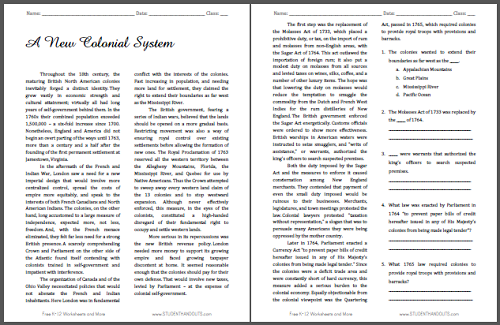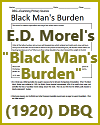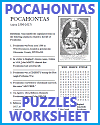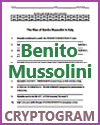| A New Colonial System Reading with Questions |
|---|
| www.studenthandouts.com ↣ American History ↣ American History Readings |
|
Throughout the 18th century, the maturing British North American colonies inevitably forged a distinct identity. They grew vastly in economic strength and cultural attainment; virtually all had long years of self-government behind them. In the 1760s their combined population exceeded 1,500,000—a six-fold increase since 1700. Nonetheless, England and America did not begin an overt parting of the ways until 1763, more than a century and a half after the founding of the first permanent settlement at Jamestown, Virginia. In the aftermath of the French and Indian War, London saw a need for a new imperial design that would involve more centralized control, spread the costs of empire more equitably, and speak to the interests of both French Canadians and North American Indians. The colonies, on the other hand, long accustomed to a large measure of independence, expected more, not less, freedom. And, with the French menace eliminated, they felt far less need for a strong British presence. A scarcely comprehending Crown and Parliament on the other side of the Atlantic found itself contending with colonists trained in self-government and impatient with interference. The organization of Canada and of the Ohio Valley necessitated policies that would not alienate the French and Indian inhabitants. Here London was in fundamental conflict with the interests of the colonies. Fast increasing in population, and needing more land for settlement, they claimed the right to extend their boundaries as far west as the Mississippi River.  The British government, fearing a series of Indian wars, believed that the lands should be opened on a more gradual basis. Restricting movement was also a way of ensuring royal control over existing settlements before allowing the formation of new ones. The Royal Proclamation of 1763 reserved all the western territory between the Allegheny Mountains, Florida, the Mississippi River, and Quebec for use by Native Americans. Thus the Crown attempted to sweep away every western land claim of the 13 colonies and to stop westward expansion. Although never effectively enforced, this measure, in the eyes of the colonists, constituted a high-handed disregard of their fundamental right to occupy and settle western lands.
The British government, fearing a series of Indian wars, believed that the lands should be opened on a more gradual basis. Restricting movement was also a way of ensuring royal control over existing settlements before allowing the formation of new ones. The Royal Proclamation of 1763 reserved all the western territory between the Allegheny Mountains, Florida, the Mississippi River, and Quebec for use by Native Americans. Thus the Crown attempted to sweep away every western land claim of the 13 colonies and to stop westward expansion. Although never effectively enforced, this measure, in the eyes of the colonists, constituted a high-handed disregard of their fundamental right to occupy and settle western lands.More serious in its repercussions was the new British revenue policy. London needed more money to support its growing empire and faced growing taxpayer discontent at home. It seemed reasonable enough that the colonies should pay for their own defense. That would involve new taxes, levied by Parliament—at the expense of colonial self-government. The first step was the replacement of the Molasses Act of 1733, which placed a prohibitive duty, or tax, on the import of rum and molasses from non-English areas, with the Sugar Act of 1764. This act outlawed the importation of foreign rum; it also put a modest duty on molasses from all sources and levied taxes on wines, silks, coffee, and a number of other luxury items. The hope was that lowering the duty on molasses would reduce the temptation to smuggle the commodity from the Dutch and French West Indies for the rum distilleries of New England. The British government enforced the Sugar Act energetically. Customs officials were ordered to show more effectiveness. British warships in American waters were instructed to seize smugglers, and "writs of assistance," or warrants, authorized the king's officers to search suspected premises. Both the duty imposed by the Sugar Act and the measures to enforce it caused consternation among New England merchants. They contended that payment of even the small duty imposed would be ruinous to their businesses. Merchants, legislatures, and town meetings protested the law. Colonial lawyers protested "taxation without representation," a slogan that was to persuade many Americans they were being oppressed by the mother country. Later in 1764, Parliament enacted a Currency Act "to prevent paper bills of credit hereafter issued in any of His Majesty's colonies from being made legal tender." Since the colonies were a deficit trade area and were constantly short of hard currency, this measure added a serious burden to the colonial economy. Equally objectionable from the colonial viewpoint was the Quartering Act, passed in 1765, which required colonies to provide royal troops with provisions and barracks. Questions with answers in bold: 1. The colonies wanted to extend their boundaries as far west as the _____. a. Appalachian Mountains b. Great Plains c. Mississippi River d. Pacific Ocean 2. The Molasses Act of 1733 was replaced by the Sugar Act of 1764. 3. Writs of assistance were warrants that authorized the king’s officers to search suspected premises. 4. What law was enacted by Parliament in 1764 “to prevent paper bills of credit hereafter issued in any of His Majesty's colonies from being made legal tender”? Currency Act 5. What 1765 law required colonies to provide royal troops with provisions and barracks? Quartering Act Click here to print. |
 |  |  |  |  |  |
| www.studenthandouts.com ↣ American History ↣ American History Readings |








